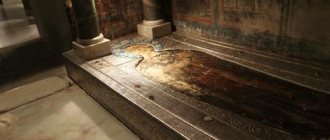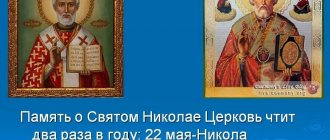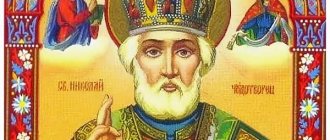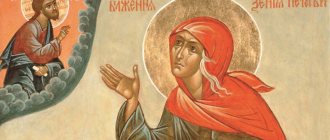The Life of Saint Nina and the Finding of the Cross
The saint was born at the end of the 3rd century into a pious and noble family. Her father Zabulon was in the military service of the emperor. At the age of 12, she and her parents went to Jerusalem, where, with the blessing of the bishop, her father became a hermit in the desert, and her mother, Susanna, became a deaconess. The girl was handed over to the pious elder Nianfora to be raised.
Learning from her mentor more and more details about the earthly life of the Lord, the saint became interested in the history of the Chiton - the robe of Christ, in which He was crucified and for which the soldiers cast lots. Nina learned that, according to legend, Chiton is located in Iveria (the ancient name of Georgia) and began to pray to the Mother of God to find him. This is what the widespread version of the life of St. Nina says, and this is what many Christians believe. According to another version, Heaton is located in the city of Trier.
Chiton of Christ in Trier
The Mother of God appeared to the girl in a dream. She handed Saint Nina a cross woven from a grapevine and said: “Go to Iberia and preach the Gospel. This cross will be your shield from all visible and invisible enemies.” When the saint woke up, the same cross lay next to her.
Relics of St. Nina in the Bodbe Monastery (Georgia)
And so it happened. Before this, pagan Iveria, through the labors of Saint Nina, accepted Christianity. The saint spent 35 years of her life preaching the Gospel in this country, and for these works the Church calls her Equal-to-the-Apostles Nina, the enlightener of Georgia. The saint found the tunic of Jesus Christ, and on this site - in the city of Mtskheta - a wooden temple was built, and later - a stone cathedral in honor of the 12 apostles.
Story
For the historiography of Georgia, several written sources are known that make it possible to determine the origin of the modern flag of Georgia. It is known that the Georgian king Vakhtang Gorgasali already in the 5th century used a white flag with the image of the red straight cross of St. George the Victorious. Also, under Queen Tamar in the 12th century, a white banner with a red cross was raised, only in addition with a star. Presumably in 1320, during the reign of George V, nicknamed the Brilliant, a five-cross flag appeared. This is connected with the return of the Monastery of the Holy Cross in Jerusalem, as well as with the capture by George V of the castles of Jerusalem, that is, the Key to the Church of the Holy Sepulcher. After this fact, various sources contain a five-cross composition, which was used to record Georgia. The five-cross flag is depicted by cartographers Pietro Visconti, brothers Francesco and Domenico Pizzigani, Gabriel De Valllseca. The flag is also often actively found in Georgia itself on medieval churches in the form of bas-reliefs, for example: Nekresi, Bochorma, Manglisi, Chkheri.
The history of the cross after the death of St. Nina
The saint died in 340. The enlightener of Georgia never parted with her cross and bequeathed it to King Mirian, who was baptized thanks to Saint Nina. In Mtskheta, the former capital of Georgia, the cross was located until 458.
Then wars and persecution began in the country. The cross of St. Nina was kept by the Armenian governor for 175 years, in the Vanadad monastery for more than 450 years, in Kars for 164 years. King David found it in the city of Ani in 1125 and moved it to Mtskheta. From there he was transferred to the Church of the Holy Trinity on Mount Kazbek. In 1746, by order of King Teimuraz II, in order to avoid desecration, the cross was hidden in the Ananur fortress. From there, in 1749, Metropolitan Roman of Tiflis secretly sent the cross to Prince Bakar. In 1801, his grandson, Georgy Alexandrovich, presented the cross to Emperor Alexander I.
The Russian emperor restored historical justice - the cross of St. Nina, as a property of the Georgian church, was sent with honors to the Zion Cathedral in Tbilisi. “...Knowing how precious this shrine is for the Georgian people and wishing by returning it to give new proof of my care for it, I sent this cross there to be placed in the Tiflis main Cathedral...” wrote Emperor Alexander I to Prince George Alexandrovich in February 1802.
Bolnisi Cross
The Bolnisi Cross is a type of Orthodox cross that has been widely used in Georgia since the 5th century. For the first time in Georgia, such a cross was found on the facade of Bolnisi Sioni. The cross has an equilateral shape and is often surrounded by a circle. In Georgia, the Bolnisi cross can be found in christened houses, as well as on a car as a talisman. On the facades of temples, two angels are depicted raising an equilateral cross. It is the Bolnisi crosses that are depicted on the sides of the Georgian flag, personifying the four authors of the Gospels, whose teachings diverge to all parts of the world.
What does the cross of St. Nina look like?
The cross of Equal-to-the-Apostles Nina is easy to recognize: the ends of its horizontal crossbar are lowered down and in appearance it resembles an abbot's or bishop's staff. It is made entirely of vines and at the junction of the crossbars is intertwined with the hair of St. Nina. In iconography, the Equal-to-the-Apostles enlightener of Georgia is usually depicted with a characteristic cross and the Gospel in her hands.
Cross of St. Nina, modern view. Photo by Gábor Tikos_Flickr_CC BY-SA 2.0
Flower meanings and symbolism
The red five-cross composition of the flag on a white background has Christian symbolism. White color is a symbol of purity and purity, red color represents courage and courage. The large rectangular cross in the center is the personification of the Son of God Jesus Christ, and the smaller crosses located in the corners are the four evangelists.
What to pray to Saint Nino
The canonical text of St. Nino’s prayer is very ancient and seems too “general”; it contains requests that could, in principle, be addressed to any of the saints of the Christian world - “to protect the flock,” “to admonish the enemies of the holy Church of Christ.” But many people pray to her in a deeply personal way. They ask her:
- about getting rid of illnesses, both physical and mental;
- about the birth of children (remember the story of the treatment of the gardener’s wife!);
- about assistance in missionary activities;
- about confirmation in faith;
- about the rescue of people caught in the network of sectarians (she led an entire people away from the warlike pagan deity to Christ);
- about assistance in travel (Nina traveled a lot until she came to the lot of the Mother of God).
According to the testimony of believers, prayer in front of the icon of the enlightener of Georgia, Equal to the Apostles Nina, has special power - even when the solution to the problem is very far away, people feel relief in their hearts.
Miracle on the royal hunt
But King Mirian remained deaf to the new teaching. He can be understood - Nina was the first Christian woman he saw, why would he even trust her words and betray his shining, victorious Armazi for the sake of the unknown Christ and exchange the sword for the cross? As often happens, the conversion to Christianity was helped by an emergency situation. While hunting on Mount Thoti, the king was “overtaken by darkness.” According to two different versions, it was either darkness that suddenly came during the white day, or blindness that struck the king.
Armazi was in no hurry to help the frightened ruler, and the king, probably remembering his wife’s stories, called on “God Nino,” swearing to believe in Him if He helped. A pragmatic king, “you give me, I’ll give you,” but it helped!
Next, Mirian confessed what had happened to Nina, and then wrote about his desire to receive holy baptism to Constantine the Great himself and his mother St. Elena. The Roman ruler, a convinced Christian, sent Bishop John, priest James and a deacon to Mirian's court to conduct the baptism ceremony of the king and his court “in full form.” Later, at the confluence of the Mktvari and Aragvi rivers, the people were baptized en masse. Since 326, Christianity has become the state religion of Georgia, and the feast of its Epiphany is celebrated by the GOC on October 1.
In Mtskheta
Nina reached Mtskheta - the capital of pagan Iberia - on the eve of August 5, the day of festivities in honor of Armazi, the pagan god of gods. Nina witnessed the worship - both the king and the people prayed to the statue of the warrior god in golden armor. Nina only had to pray to Christ with a request to convert all these people to a different faith. The legendary version that, through Nina’s prayer, the Christian god destroyed the idol with lightning is hardly more than a fairy tale - similar stories are told about many other Christian saints, based on the stories of the miracles of the Old Testament prophets who called fire from heaven. Much more interesting and original is another story about a saint - about a miracle during the hunt of King Mirian.
In Mtskheta, Nina settled with the gardener of the royal garden. In addition to preaching the faith, she was also involved in healing (she won the gardener’s heart by curing his wife of infertility). The gift of healing attracted people to her (there are many preachers, but the gift of saving lives is not given to everyone). The first followers of Nina in Christ were women: she healed children, saved a child who was seriously ill from birth - what kind of woman would be left indifferent by such an act? Nina was also accepted by ladies who occupied far from the last places in the social hierarchy of Mtskheta - the wife of Prince Revy Salome, the wife of Eristavi (a title approximately corresponding to the ducal title in the West) Perezhavra, and even the wife of the supreme ruler - Queen Nana (Nina healed her of a serious illness).
In search of Christ's robe
With the name of Jesus Christ on her lips, Nina set off on the road. Her path was not easy - she happened to witness martyrdom for the faith and was miraculously lucky not to suffer herself. At some point on her journey, Nina met the bride of Christ Hripsimia, her mentor in the faith Gaiania and other nuns - and shared with them the flight from Emperor Diocletian. He, without feeling personal hostility towards Christians, expelled them as undermining the authority of his government. The fans of the wandering Jewish preacher Diocletian were not impressed - he preferred to be greeted like a deity. The legend that he was inflamed with passion for the maiden Hripsimia is hardly true. The emperor was married, and to a Christian woman - however, he forced her to make sacrifices to the Roman gods. Gaiania, Ripsimia and other women suffered because they did not want to do this - Diocletian sentenced Christians who did not recognize the power of Jupiter over themselves to death.
Christian women fled to Armenia, the patrimony of King Tiridates (or, in the Greek tradition, Tiridates). Diocletian managed to write to him about them - and casually told him about the beauty of Ripsimia. So the poor maiden had to experience the passion of the king of the earth. But she wished to remain faithful to Heaven. The enraged Tiridates executed Hripsime, Eldress Gaiania and their companions (the Armenian Orthodox Church still honors Saints Hripsime and Gayane). Nina miraculously managed to escape persecution and on June 1 set foot on Georgian soil - she entered the lot of the Mother of God.











